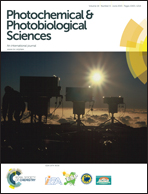Subtle structural changes in octupolar merocyanine dyes influence the photosensitized production of singlet oxygen†
Abstract
The photophysical properties of two indoline-based octupolar merocyanine dyes and of the corresponding quinoline-based dyes were examined. This seemingly subtle structural change in the chromophore of these molecules has an appreciable effect on the yields with which these respective compounds sensitize the production of singlet molecular oxygen, O2(a1Δg). The indoline-based dyes are reasonably efficient O2(a1Δg) sensitizers (ϕΔ ∼ 0.35), whereas the quinoline-based dyes are poor O2(a1Δg) sensitizers (ϕΔ ∼ 0.005). A series of experiments, including Laser-Induced Optoacoustic Calorimetric (LIOAC) measurements, reveal that this difference principally reflects the fact that the excited singlet state of the quinoline-based dyes rapidly and efficiently decays via nonradiative channels to regenerate the ground state molecule. It is likely that a charge-transfer state mediates this efficient coupling between the excited and ground states. Such subtle, structure-dependent effects are important in elucidating and ultimately understanding phenomena that influence the efficiency of photosensitized O2(a1Δg) production. In turn, the knowledge gained facilitates the rational design and preparation of O2(a1Δg) sensitizers with explicitly controlled properties.


 Please wait while we load your content...
Please wait while we load your content...